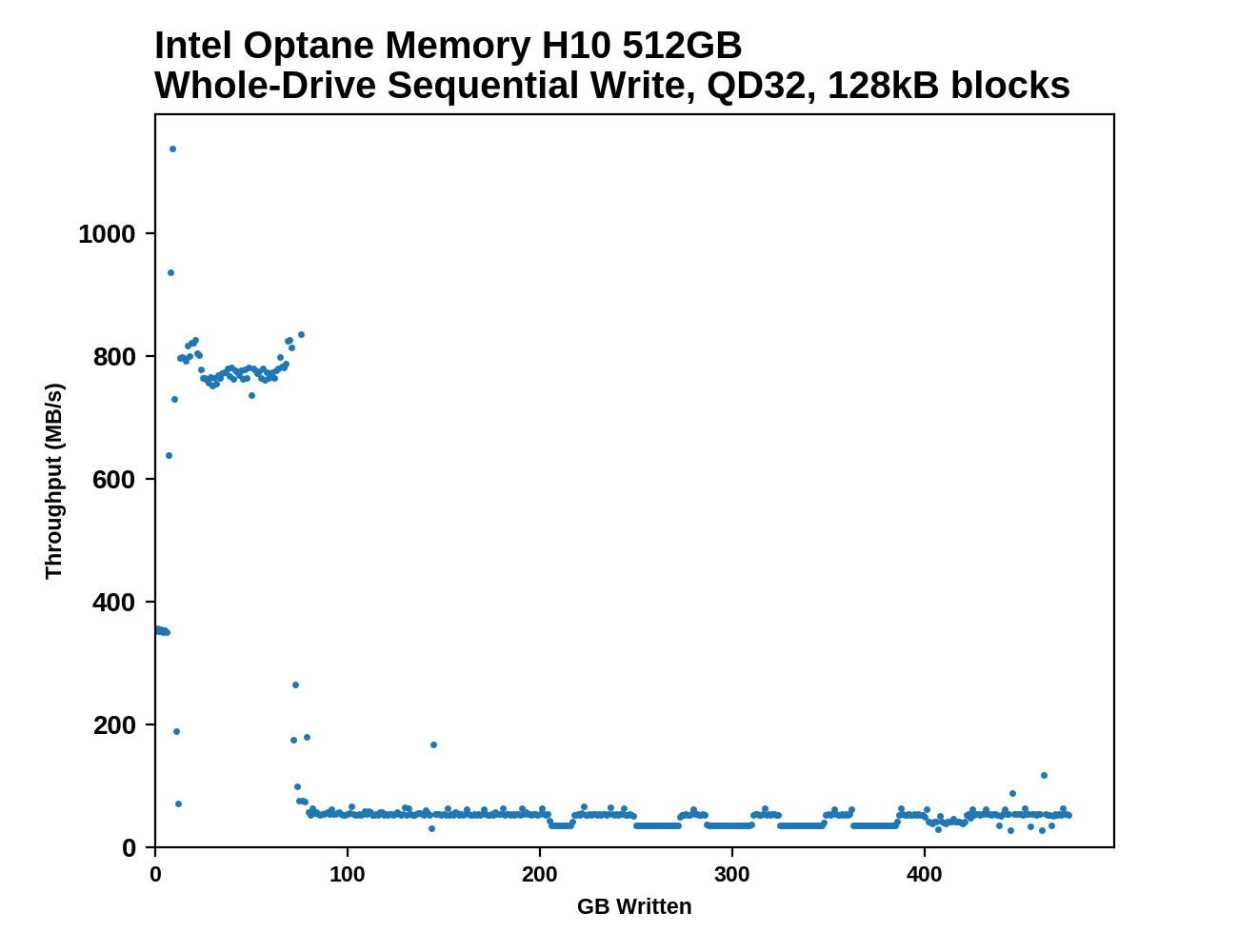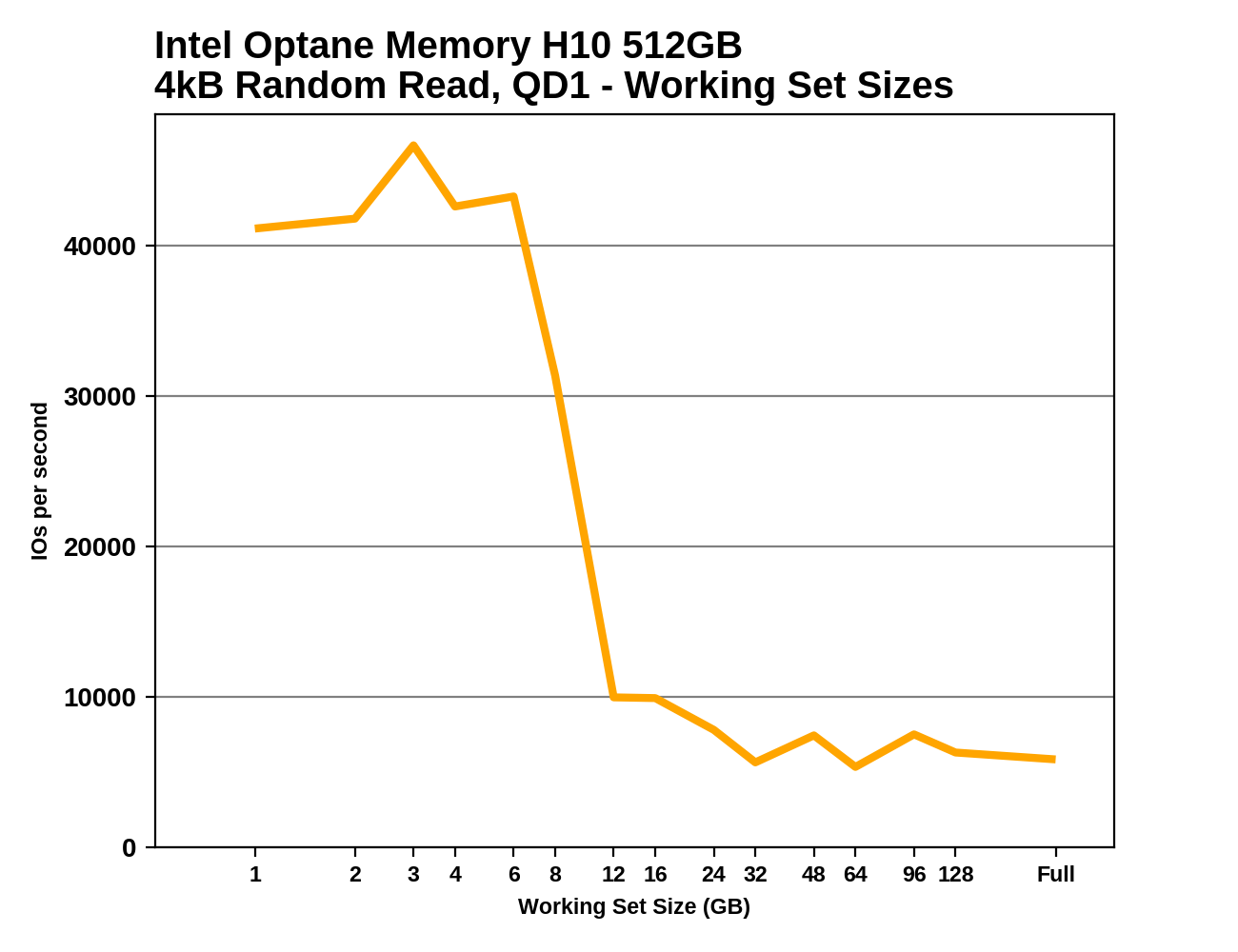The Intel Optane Memory H10 Review: QLC and Optane In One SSD
by Billy Tallis on April 22, 2019 11:50 AM ESTWhole-Drive Fill
This test starts with a freshly-erased drive and fills it with 128kB sequential writes at queue depth 32, recording the write speed for each 1GB segment. This test is not representative of any ordinary client/consumer usage pattern, but it does allow us to observe transitions in the drive's behavior as it fills up. This can allow us to estimate the size of any SLC write cache, and get a sense for how much performance remains on the rare occasions where real-world usage keeps writing data after filling the cache.
 |
|||||||||
During a sustained write, the Optane cache on the Intel Optane Memory H10 doesn't change the situation much from how the QLC-only Intel 660p behaves—the Optane cache on its own is only good for about 350MB/s. The SLC write cache on the NAND side is a more important factor that helps sustain high write speed far beyond the 32GB size of the Optane cache. But eventually, all the caches fill up and the very slow write speed of raw QLC takes over.
 |
|||||||||
| Average Throughput for last 16 GB | Overall Average Throughput | ||||||||
The overall average write speed when completely filling the Optane Memory H10 is unsurprisingly lower than any of the other drives in this batch. The 1TB Intel 660p was already a bit slower than a 7200RPM hard drive, and our H10 sample has half as much QLC to work with.
Working Set Size
 |
|||||||||
The Optane cache on the H10 is 32GB, but when testing random reads it appears to only be good for about 6-8GB working sets before the cache starts thrashing and performance drops down to roughly what a QLC-only drive can offer. It appears that Intel may be reserving a large portion of the Optane cache to serve as a write buffer, and this might be detrimental to the most read-intensive workloads.










60 Comments
View All Comments
The_Assimilator - Tuesday, April 23, 2019 - link
> I don't understand the purpose of this product.It's Intel still trying, and still failing, to make Optane relevant in the consumer space.
tacitust - Tuesday, April 23, 2019 - link
It works in the sense that the OEMs who use this drive will be able to use the fact that customers will be getting cutting edge Optane storage. As the review says, this is a low effort solution, so it likely didn't cost much to develop, so they won't need too many design wins to recoup their costs. It also gets Optane into many more consumer devices, which helps in the long run in terms of perception, if nothing else.Note: most users won't know or even care that the drive itself doesn't provide faster performance than other solutions, so it doesn't really matter to Intel either. If they get the design win, Optane does gain relevance in the consumer space, just not with the small segment of power users who read AnandTech for the reviews.
ironargonaut - Monday, April 29, 2019 - link
Seems it does provide faster performance in some usage cases.https://www.pcworld.com/article/3389742/intel-opta...
CheapSushi - Wednesday, April 24, 2019 - link
I can't stand these dumb posts where people shut down the usage for consumers. I use it all the time for OS and other programs/files. I use it as cache. I use it for different reasons. Even the cheap early x2 laned variants. I'm not in IT or anything enterprise.name99 - Thursday, April 25, 2019 - link
It's worse than that.The OPTANE team clearly want to sell as many Optanes as they can.
But INTC management has decided that they can extract maximal money from enterprise by limiting
name99 - Thursday, April 25, 2019 - link
It's worse than that.The OPTANE team clearly want to sell as many Optanes as they can.
But INTC management has decided that they can extract maximal money from enterprise by limiting the actually sensible Optane uses (in the memory system, either as persistent memory ---for enterprise, or as a good place to swap to, for consumers).
And so we have this ridiculous situation where the Optane team keeps trying to sell Optane in ways that make ZERO sense because the way that makes by far the most sense (sell a 16 or 32 GB or 64GB DIMM that acts as the swap space) is prevented by Intel high management (who presumably are scared that if cheap CPUs can talk to Optane DIMMs, then someone somewhere will figure out how to use them in bulk rather than super expensive special Xeons).
Corporate dysfunction at its finest...
Billy Tallis - Friday, April 26, 2019 - link
I think it's too soon to say that Intel's artificially holding back Optane DIMMs from market segments where they might have a chance. They had initially planned to have Optane DIMM support in Skylake-SP but couldn't get it working until Cascade Lake, which has only been shipping in volume for a few months. Now that they have got one working Optane-compatible memory controller out the door, they can consider bringing those memory controller features down to other product segments. But we've seen that they have given up on updating the memory controllers on their 14nm consumer parts even to provide LPDDR4 support, which certainly is a more compelling and widely-demanded feature than Optane support. I wouldn't expect Intel to be able to introduce Optane support to their consumer CPUs until their second generation of 10nm (not counting CNL) processors at the earliest. Trying to squeeze it into their first mass-market 10nm would be unreasonable since they should be trying at all costs to avoid feature creep on those parts and just ship something that works and isn't still Skylake.ironargonaut - Monday, April 29, 2019 - link
Read here for an actual real world usage test. Two system with only memory difference and same input sometimes significantly different results.https://www.pcworld.com/article/3389742/intel-opta...
3X speed up for some tasks. I don't know about ya'll but I multitask a lot at work so I will let background stuff go while I do something else that is in front of me.
weevilone - Monday, April 22, 2019 - link
That's too bad. I tried to tinker with the Optane caching when it launched and it was a software disaster. I wrote it off to early days stuff and put it in my kids' PC when they began to allow non-boot drives to be cached. It was another disaster and Intel's techs couldn't figure it out.I wound up re-installing Windows the first time and I had to redo the kids' game drive the second time. No thanks.
CheapSushi - Wednesday, April 24, 2019 - link
The problem is you were using the proprietary HDD caching they marketed. There are so many ways to do drive caching on Windows that doesn't involve that Intel software. It's way better and smoother. even if still software. Software RAID and cache is superior to hardware cache unless you're using $1K+ add-on cards.